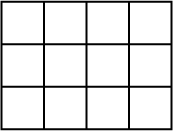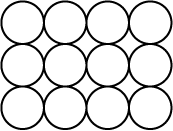Home > Patterns > Misunderstandings > Tessellations
Tessellations
While some shapes fit together to make a two-dimensional repeating pattern that leaves no gaps, this is not possible for other shapes.
Compare how squares and circles fit together in a rectangular pattern.
|
|
|
A pattern of shapes that fit together without any gaps is called a tessellation. So squares form a tessellation (a rectangular grid), but circles do not.
Tessellations can also be made from more than one shape, as long as they fit together with no gaps.
Through exploring how shapes fit together, students can learn much about those shapes. They can learn about the number and lengths of the sides of each shape, as well as the angles at the corners. They can also encounter concepts such symmetry, congruence, similarity and parallels.
Making tessellations
Tessellations can easily be investigated with pattern blocks (with or without digital technology).
Growing patterns can tessellate
The video Let's Make a Pattern! can inspire students to create their own two-dimensional growing patterns.



